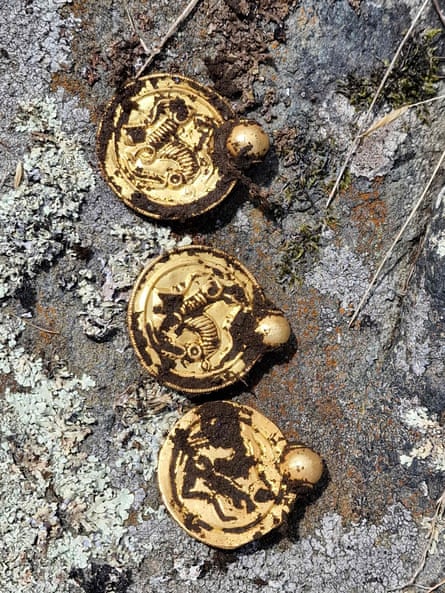silvercoinboy
Well-known member
Wow!!
A Norwegian man out walking on doctors’ advice unearthed rare sixth-century gold jewellery using a newly bought metal detector, in a discovery archaeologists have hailed as Norway’s “gold find of the century”.
The cache comprised nine gold medallions and gold pearls that once formed an opulent necklace, as well as three gold rings. The jewels, which weigh a little more than 100g, were found to date from about AD500.
“At first I thought it was chocolate coins or Captain Sabertooth coins,” said Erlend Bore, 51, referring to a fictional Norwegian pirate. “It was totally unreal.”
Archaeologists say the find is unique because of the design on the medallions: a type of horse from Norse mythology.

The medallions feature a horse from Norse mythology.Photograph: Erlend Bore/NTB/AFP/Getty Images
Bore, who dreamed of becoming an archaeologist as a child, made the discovery on the southern island of Rennesøy, near Stavanger, in August after he bought a metal detector on his doctors’ recommendation to get more exercise.
He had been out searching and was about to head home for the day when the device suddenly began beeping on a hillside.
He called archaeologists, who took over the search.
Ole Madsen, head of the University of Stavanger’s Museum of Archaeology, said it was “the gold find of the century in Norway. To find that much gold all at once is extremely unusual.”
Håkon Reiersen, an associate professor at the museum, said the gold pendants – flat, thin, single-sided gold medals called bracteates – dated from the so-called migration period in Norway, which ran between AD400 and about AD550, when there were widespread migrations in Europe.
“Given the location of the discovery and what we know from other similar finds, this is probably a matter of either hidden valuables or an offering to the gods during dramatic times,” he said.
The pendants and gold pearls were part of “a very showy necklace” made by skilled jewellers and worn by society’s most powerful, said Reiersen. He added that “in Norway, no similar discovery has been made since the 19th century, and it is also a very unusual discovery in a Scandinavian context”.
Prof Sigmund Oehrl, who also works at the Stavanger Museum, said that symbols on the pendants usually showed the Norse god Odin healing the sick horse of his son. On the Rennesøy ones, the horse’s tongue hangs out on the gold pendants, and “its slumped posture and twisted legs show that it is injured”, Oehrl said.
“The horse symbol represented illness and distress, but at the same time hope for healing and new life,” he added.
In line with Norwegian law, Bore and the landowner will receive a reward, although the sum has not yet been determined. Objects from before 1537, and coins older than 1650, are considered state property and must be handed in.
Metal detectorist makes Norway’s ‘gold find of century’
Erlend Bore, who was out walking on doctor’s orders, finds cache including rare medallions from about AD500A Norwegian man out walking on doctors’ advice unearthed rare sixth-century gold jewellery using a newly bought metal detector, in a discovery archaeologists have hailed as Norway’s “gold find of the century”.
The cache comprised nine gold medallions and gold pearls that once formed an opulent necklace, as well as three gold rings. The jewels, which weigh a little more than 100g, were found to date from about AD500.
“At first I thought it was chocolate coins or Captain Sabertooth coins,” said Erlend Bore, 51, referring to a fictional Norwegian pirate. “It was totally unreal.”
Archaeologists say the find is unique because of the design on the medallions: a type of horse from Norse mythology.

The medallions feature a horse from Norse mythology.Photograph: Erlend Bore/NTB/AFP/Getty Images
Bore, who dreamed of becoming an archaeologist as a child, made the discovery on the southern island of Rennesøy, near Stavanger, in August after he bought a metal detector on his doctors’ recommendation to get more exercise.
He had been out searching and was about to head home for the day when the device suddenly began beeping on a hillside.
He called archaeologists, who took over the search.
Ole Madsen, head of the University of Stavanger’s Museum of Archaeology, said it was “the gold find of the century in Norway. To find that much gold all at once is extremely unusual.”
Håkon Reiersen, an associate professor at the museum, said the gold pendants – flat, thin, single-sided gold medals called bracteates – dated from the so-called migration period in Norway, which ran between AD400 and about AD550, when there were widespread migrations in Europe.
“Given the location of the discovery and what we know from other similar finds, this is probably a matter of either hidden valuables or an offering to the gods during dramatic times,” he said.
The pendants and gold pearls were part of “a very showy necklace” made by skilled jewellers and worn by society’s most powerful, said Reiersen. He added that “in Norway, no similar discovery has been made since the 19th century, and it is also a very unusual discovery in a Scandinavian context”.
Prof Sigmund Oehrl, who also works at the Stavanger Museum, said that symbols on the pendants usually showed the Norse god Odin healing the sick horse of his son. On the Rennesøy ones, the horse’s tongue hangs out on the gold pendants, and “its slumped posture and twisted legs show that it is injured”, Oehrl said.
“The horse symbol represented illness and distress, but at the same time hope for healing and new life,” he added.
In line with Norwegian law, Bore and the landowner will receive a reward, although the sum has not yet been determined. Objects from before 1537, and coins older than 1650, are considered state property and must be handed in.




 sube
sube